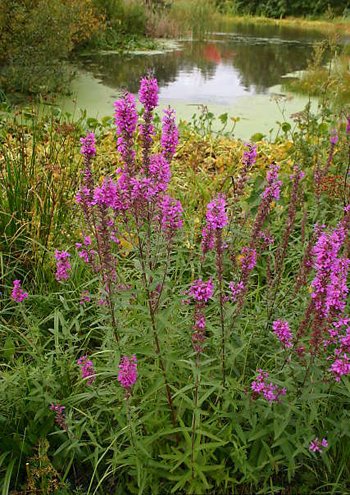Contents:
Common Names | Parts Usually Used | Plant(s) & Culture | Where Found | Medicinal Properties | Biochemical Information
Uses | Formulas or Dosages | Bibliography
Scientific Names

- Lythrum salicaria L.
- Lythraceae
- Primrose family
Common Names
- Chen-chu-ts’ai (Chinese name)
- Grass-poly
- Long purples
- Milk willow-herb
- P’ai-ts’ao
- Purple loose-strife
- Purple willow-herb
- Rainbow weed
- Soldiers
- Spiked loosestrife
- Spiked willow-herb
- Willow sage
Parts Usually Used
The whole plant, fresh or dried in the shade
Back to Top
Description of Plant(s) and Culture
Loosestrife is a bushy, erect, perennial plant with a clump of unbranched, four-angled, tall leafy stems; the square, hairy stem grows 2-4 feet high and bears heart-shaped, lanceolate, downy leaves. The lance-shaped leaves grow in opposite pairs or in whorls of three, their bases clasping the stems. Whorls of purple six-petaled flowers grow in the axils off the upper leaves in dense terminal spikes from June to August.
Another variety: Whorled loosestrife (Lysimachia quadrifolia).
Back to Top
Where Found
Settled in swamps, marshes, along lakes and rivers, wet meadows, roadside ditches, and moist places in the eastern United States after being introduced from Europe. From Newfoundland to Minnesota and south to Virginia and Missouri.
Back to Top
Medicinal Properties
Astringent, styptic, demulcent, alterative
Back to Top
Biochemical Information
A glycoside, polyphenolic tannins, pectin and essential oil
Back to Top
Uses
Loosestrife is effective against diarrhea, including simple diarrhea and that associated with serious illnesses such as dysentery and typhoid fever. The infusion or fluid extract is used for gastroenteritis and is particularly useful for diarrhea in infants. It helps to stop internal bleeding, and it works without producing constipation. Reduces inflammation, relieves hoarseness, and feverish colds. A cold compress of the herb stops bleeding from wounds and cuts; helps bruises and sores to heal. Sometimes used as a gargle for sore throats, or a douche for leukorrhea.
Externally, it is used as an eyewash for ophthalmia, sore eyes, and various skin diseases.
Back to Top
Formulas or Dosages
Infusion: steep 1 oz. fresh herb in 1 cup water.
Decoction: boil 1 oz. herb in 1 pint of water until 1 cup liquid remains. Take 4 tbsp., 3 times a day.
Fluid extract: usual dose for infants is 10-15 drops; for adults, 1 tsp.
For gargle: with infusion or with 10 drops diluted in a glass of warm water.
Back to Top
Bibliography
![]() The Herb Book
The Herb Book, by John Lust, Bantam Books, 666 Fifth Avenue, New York, NY. copyright 1974.
![]() Eastern/Central Medicinal Plants
Eastern/Central Medicinal Plants, by Steven Foster and James A. Duke., Houghton Mifflin Company, 215 Park Avenue South, New York, NY 10000
![]() Culpeper’s Complete Herbal & English Physician: Updated With 117 Modern Herbs
Culpeper’s Complete Herbal & English Physician: Updated With 117 Modern Herbs, by Nicholas Culpeper, Meyerbooks, publisher, PO Box 427, Glenwood, Illinois 60425, 1990, (reprint of 1814)
![]() Chinese Medicinal Herbs
Chinese Medicinal Herbs, compiled by Shih-Chen Li, Georgetown Press, San Francisco, California, 1973.
 The Magic of Herbs
The Magic of Herbs, by David Conway, published by Jonathan Cape, Thirty Bedford Square, London, England. (Out of print)
![]() Planetary Herbology
Planetary Herbology, by Michael Tierra, C.A., N.D., O.M.D., Lotus Press, PO Box 325, Twin Lakes. WI 53181., Copyright 1988, published 1992
![]() Webster’s New World Dictionary
Webster’s New World Dictionary, Third College Edition, Victoria Neufeldt, Editor in Chief, New World Dictionaries: A Division of Simon & Schuster, Inc., 15 Columbus Circle, New York, NY 10023
![]() The Complete Medicinal Herbal
The Complete Medicinal Herbal, by Penelope Ody, Dorling Kindersley, Inc, 232 Madison Avenue, New York, NY 10016, First American Edition, copyright 1993
 An Instant Guide to Medicinal Plants
An Instant Guide to Medicinal Plants, by Pamela Forey and Ruth Lindsay, Crescent Books (January 27, 1992).
![]() The Yoga of Herbs: An Ayurvedic Guide to Herbal Medicine
The Yoga of Herbs: An Ayurvedic Guide to Herbal Medicine, by Dr. David Frawley & Dr. Vasant Lad, Lotus Press, Twin Lakes, Wisconsin, Second edition, 1988.
